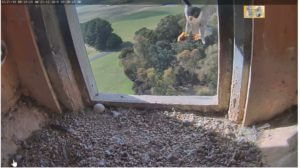This will be a quick update as I went to Sydney this week to measure skins of birds commonly used as prey by our peregrines at the Australian Museum. I was assisted in this by the Birds Collection supervisor, Dr. Leah Tsang, who was extremely helpful providing not just the samples, but also advice and equipment. I had a tiring trip back involving nine hours travel, two different trains and two different buses because of the electrical storms caused both a rail network shutdown and road closures….got to bed at 0400 h!
The reason I’m doing this is because I want to analyse the prey that they are taking by size. Obviously if I know the species, this is a simple task, but usually the prey comes in headless, wingless, tail-less and often featherless as well, making identification tricky (I’m getting quite good at identificaiton based on feet!). So I’m trying to classiy them by size by comparing the length of their torso to that of the peregrine male of female ie using ratios. Having known ratios from actual bird skins is a useful start to see how much variability there is in the data where I have already identified prey. If this is consistent, then I can be reasonably confident of the methodology, although I still need to be cautious as these were birds with no bone structure, so measurements were tricky. I did intend to measure width, but once I had done the lengths and physically moved the samples into their size categories based on length, it didn’t seem as if width would make much difference except for species such as rails, which are very rarely taken.
Of course many will still not be able to be even classified, except as ‘morsel’. Here is Xavier with an example! Followed by a university-educated hare, just below the nest-box just for something different! . Does he know peregrines do just occasionally take mammals??
All the best for Christmas and New Year. I will be around as I want to check and see if the juveniles are still here. I thought they might have gone, but I believe they were seen as recently as yesterday. I also have to look after my plants in the nursery.
Cilla


and a nice ‘chat’ between Xavier (who was in the box, but leaves after) and Diamond (who arrives and stays)
https://youtu.be/h7Fzso9lmok
and note new nestcam address for live feed (thanks, Sue):
https://www.youtube.com/watch?v=8MUZP3HZCEk
Thanks for your report Cilla. So it was a difficult journey because of the bad weather, but very informative at the museum.
Lovely picture of the brave hare. 😀
Must’ve been a frustrating trip home in apocalyptic weather! Very satisfying, though, to be able to work on your methodology via the museum’s collection at last.